Huet 7x50 "Dientsglas"
| Zur Zeit der deutschen Besatzung Frankreich wurde dieses 7x50 Porro-II-Glas von der Fa. Huet für die deutsche Wehrmacht gefertigt. Der runde Deckel ist mit 7x50, dem Huet-Logo und der Nummer 397 sowie darunter der Bezeichnung "Dienstglas" markiert. Es sind zwar alle Angaben auf dme Deckel, dennoch handelt es sich um die rechte Hälfte eines Binokulars, da abgesägte Stellen der Fernglasbrücke zu erkennen sind (s. Bild 2). Das Monokular hat eine ockerne Tarnlackierung, unter der z.T. eine rötliche Grundierung, vermutlich Rostschutz zu sehen ist. Ebenso sind einige Stellen durch Wasser korrodiert, was vermuten lässt, dass das Fernglas auch als Marineglas (7x50 ist eine typische Kenngröße) eingesetzt wurde, zumal da das Okular einen feste Gelbfiltertönung und eine Strichplatte vom links 30 nach rechts 30 aufweist. An der Unterseite der Prismendose ist ein Ansatzventil für ein Trockengerät. Wie die anderen Porro-2-Prismengläser von Huet hat es eine Geradführung des Okulars. Das Gehäuse ist aus Aluminium. die Optik ist nicht vergütet. | During German occupation of france this 7x50 porro 2 glass by Huet Paris was made for the German "Wehrmacht". The round cover plate is marked "7x50", then the Huet logo and number 397, below this the word "Dienstglas". Though there is all important data at the cover plate, this just is a right half of a binocular, because you can see blank spots where the bridge was sawn off (s. pic 2). The glass is camouflage with a ochre paint, showing signs of some red paint below which could be an anti-rust priming coat. Other parts are corroded by water. The latter lets me assume that this glass was used as a marine glass – 7x50 being a typical specifications for that. Moreover, the monocular has a yellow tinted ocular and a reticle with division lines from 30 to 30 left to right. There is a desiccation apparatus valve at the lower plate of the prism housing. Like other Huert glasses focusing has a linear movement. The housing is made of aluminium, the optics are uncoated. |
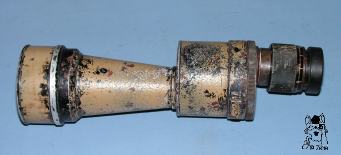
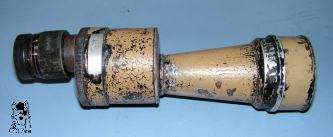
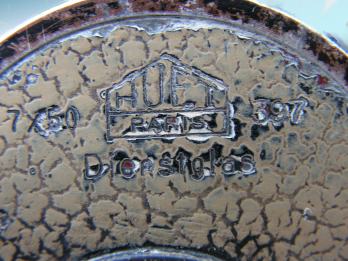
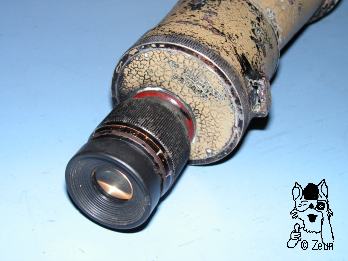
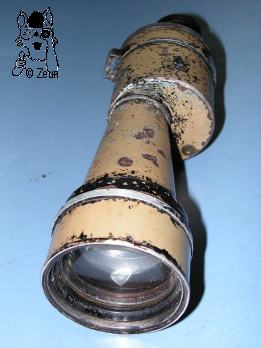
| Das Glas ist zwischen 23,5 und 24,5 cm lang und wiegt 618g. Die Bakelitaugenmuschel ist 38mm, der gerillte Fokussierungsteil 40mm im Durchmesser. Die Prismendose ist oben 65mm, ansosnten 62mm im Durchmesser, der Objektivtubus verbreitert sich von 33 auf 60mm und am äußersten Ring 65,5mm; der gerade Objektiv-Abschlussteil ist 64mm im Durchmesser. Das Prismengehäuse ist 62mm, der Objektivtubus 12,5cm lang. | The glass is between 23.5cm and 24.5cm tall, and weighs 618g. The Bakelite eyecup is 38mm, the knurled focusing piece 40mm, and the prism box is 65mm at the top and 62mm at its lower part in diameter. The objective tube broadens from 33mm to 60mm, ending with c. 65.5mm in diameter at its outward ring. The straight objective tube is 64mm in diameter. The prism box is 62mm, the objective tube 12.5cm in length. |
Fotos: Zeun

